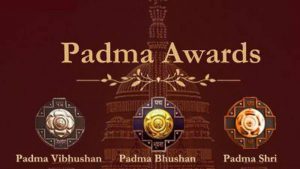Padma Awards:

The President of India conferred 4 Padma Vibhushan, 10 Padma Bhushan, and 57 Padma Shri Awards at the Civil Investiture Ceremony-I at Rashtrapati Bhawan’s Ganatantra Mandap
- The Padma Awards were established in 1954 alongside the Bharat Ratna.
- Initially, Padma Awards had three classes: Pahela Varg, Dusra Varg, and Tisra Varg.
- These were renamed in 1955 via Presidential Notification as: Padma Vibhushan, Padma Bhushan and Padma Shri
- Padma Awards Categories
- Padma Vibhushan: Awarded for exceptional and distinguished service.
- Padma Bhushan: Conferred for distinguished service of a high order.
- Padma Shri: Recognises distinguished service in any field.
- Eligibility Criteria
- All persons, regardless of race, occupation, position or gender, are eligible for the award.
- Government servants, including employees of Public Sector Undertakings (PSUs), are not eligible, except doctors and scientists.
- Awards are normally not conferred posthumously, but in highly deserving cases, exceptions are allowed.
- A minimum 5-year gap is required for conferring a higher category Padma award upon a previously awarded individual. However, this can be relaxed by the Awards Committee in exceptional cases.
- Nominations are open to the public, and self-nomination is also allowed.
- All nominations are evaluated by the Padma Awards Committee, which is constituted annually by the Prime Minister.
- The Committee is headed by the Cabinet Secretary.
- Its recommendations are submitted to the Prime Minister and President for final approval.
- The awards are presented by the President, usually in March or April.
- Awardees receive a Sanad (certificate) signed by the President and a medallion.




